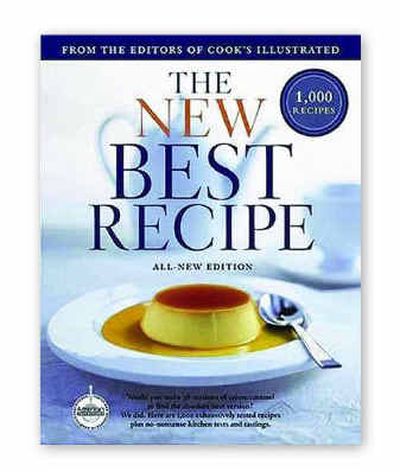New books don’t skimp on details

It’s not exactly a new genre of cookbook, the mega-page, 1,000-recipe, no-photos tome that strapped to sturdy shoulders could double as a bullet-proof vest, but when this specialized form of kitchen guidance starts popping up in twosies, count on attention from the food world.
“This fall, I think there will be an emphasis on these cookbooks,” says Christopher Kimball, the guiding force behind “The New Best Recipe,” released earlier this month. His book hit the shelves just days after “The Gourmet Cookbook,” edited by Gourmet magazine’s Ruth Reichl, stealing a glimmer of its limelight and riding on its gravy train of blockbuster publicity.
Kimball is the man behind Cook’s Illustrated and public television’s “America’s Test Kitchen,” a real place in Brookline, Mass., where his cooking show is produced and his recipes tested to within an inch of their lives. Reichl is the author of the memoirs “Comfort Me With Apples” and “Tender at the Bone,” and a former New York Times restaurant critic.
Kimball’s “The New Best Recipe” is a revision of his 1999 “The Best Recipe.” Like his magazine, the books revel in the science of cooking – what does and doesn’t work and why. He and his staff exhaustively test recipes in the quest for perfection, and their followers are legion.
“There were holes in the first book,” he says, “and we basically doubled the recipe count. Now we have a comprehensive American cookbook.”
For the Gourmet effort, Reichl and staff, especially longtime editors Zanne Stewart and Kemp Minifie, slogged through the magazine’s archives of more than 60,000 recipes, winnowing the final cut to 1,200. Many had to be reworked, tested and retested to guarantee success in today’s home kitchen.
Time will tell whether these books will rub the well-worn patina off others of their ilk, namely “Joy of Cooking,” “Fannie Farmer,” “Better Homes and Gardens” and the more recent “How to Cook Everything” by Mark Bittman.
One thing’s for sure, their release spells confusion this holiday season as those looking for kitchen guidance or gifts decide which to take home.
Don’t expect either to be the only cookbook you’ll ever need. Never mind that Reichl has repeatedly said hers has “every recipe you would ever want.” No book is that complete, no cook so easily satisfied.
Also, for books meant to live in your hands, both are large and bowling-ball heavy, and just about as clunky to handle. They are well-constructed, however, and lie flat when open.
Here’s a rundown of each:
“The Gourmet Cookbook”
Gourmet magazine was at the forefront of bringing us the pleasures of the world on a plate. This cookbook stays the global course.
Along with the likes of “arguably the best mac and cheese on the planet” and skillet corn bread are dishes fast becoming just as much a reflection of American culture, such as Vietnamese Beef Noodle Soup (Pho) and Mexican Tea Cakes. And only Gourmet would offer recipes for both Italian and Parisian gnocchi, the latter made with a pate a choux (cream puff pastry).
Within its sunny yellow cover is a personal feel, with Reichl’s voice throughout. I appreciate the cook’s notes, longed for more go-with suggestions for dishes, and cursed the yellow recipe titles, which I found nearly impossible to read.
The index is mostly useful, but there’s a glitch or two. Hungry for brownies? Look under “c,” not “b.” They are chocolate, you know.
I tested the Apple Crisp, an impressive autumn dessert Reichl borrowed from Claire Archibald’s kitchen at the now-defunct Cafe Azul in Portland, and the meltingly tender and wholly satisfying Brisket a la Carbonnade, the beef braised in a bay leaf-scented beer and balsamic bath. Both worked like a dream and were met with raves.
You’ll find primers on rice and Asian noodles, tips on storing tomatoes and buying rhubarb, a smattering of techniques, a decent glossary, and a source list for both food and equipment. It’s written for the masses, with plenty of quick and easy recipes, and you will appreciate the two sturdy ribbons for marking pages.
Perhaps its truest endorsement is that after an original printing of 250,000 copies, a second printing is on its way, says Reichl.
“There’s room for lots of cookbooks on all of our shelves,” she adds. “For me, personally, this is the one that’s living in my kitchen.”
Bottom line: It feels a little self-important, and I can’t say it’s inspiring – I usually find more recipes I want to try in a single issue of the magazine. That said, it’s solid and cook-friendly.
“The New Best Recipe”
Kimball is king at making stark look good. He’s done it for years in Cook’s Illustrated. Kitchen science rules here, not fancy typeface and pretty photos. Call me crazy, but I’m not always in the mood to wade through it, and resent feeling I must or I’ll miss something.
It’s also not adventurous or creative – think Breaded Chicken Cutlets, Corn Muffins and Quick Cinnamon Buns – but that’s not the point. Kimball sticks to dependable, straightforward recipes so cooks have success. I made the Broccoli Rabe With Asian Flavors and it was good, but what’s better is I learned a foolproof method for blanching the bitter greens.
“People have forgotten how to cook every day,” he says. “Ask them to make baking powder biscuits and they don’t know where to start.”
Where “Gourmet” takes a global look at cooking, this book is distinctly American (yes, but do we really need a recipe for American Sandwich Bread?). Interspersed, but not heavily, are recipes for more exotic fare, such as Bolognese Sauce, Pozole, and Spicy Stir-Fried Sesame Chicken.
Bottom line: As a basic cooking reference for the times, it can’t be beat. More how-tos and helpful line drawings than you can shake a whisk at. The product taste-tests and state-of-the-art kitchen advice are alone worth the price.